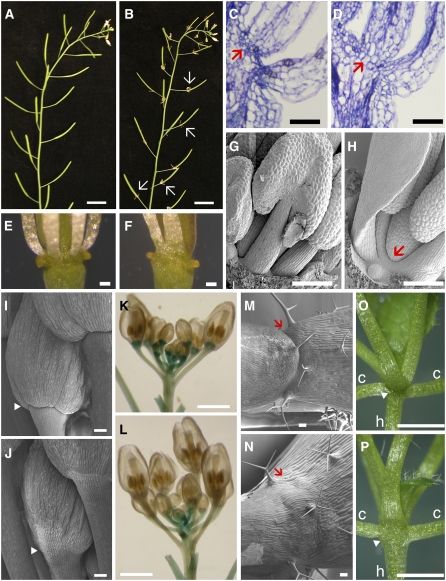Figure 1.
ATH1 Is Required to Form the Basal Boundaries of Shoot Organs.
(A) and (B) Inflorescences of wild-type (A) and ath1-3 (B) plants, showing that stamens remain attached to the developing fruits of ath1-3 (arrows).
(C) and (D) Sections through the base of flowers, with arrows indicating the dehiscence zone at the base of a wild-type stamen (C) and the corresponding region in ath1-3 (D).
(E) and (F) Closeups of the base of mature stamens in the wild type (E) and in ath1-3, which has partially fused stamens in this region (F).
(G) and (H) Scanning electron micrographs of stage 11 wild-type (G) and ath1-3 (H) flowers; the arrow shows the partial fusion at the base of stamens in ath1-3.
(I) and (J) Scanning electron micrographs of wild-type (I) and ath1-3 (J) floral buds, with arrowheads indicating the boundary between sepals and pedicel.
(K) and (L) Whole-mount staining of BP:GUS in wild-type (K) and ath1-3 (L) backgrounds.
(M) and (N) Scanning electron micrographs of the base of cauline leaves of the wild type (M) and ath1-3 (N); arrows indicate the boundary between the leaf and inflorescence stem.
(O) and (P) Base of the rosette of 2-week-old wild-type (O) and ath1-3 (P) plants; h and c mark the hypocotyls and the petioles of cotyledons, respectively, and the arrowheads show the boundary at the base of leaf petioles.
Bars = 1 cm in (A) and (B), 1 mm in (K), (L), (O), and (P), and 100 μm in (C) to (J), (M), and (N).

